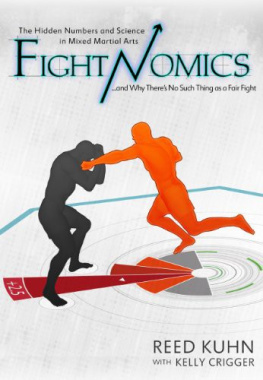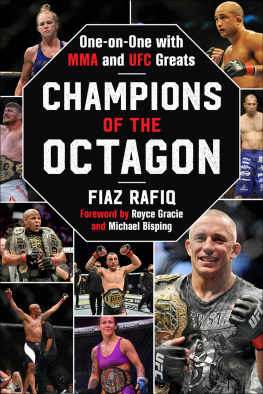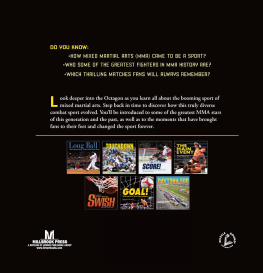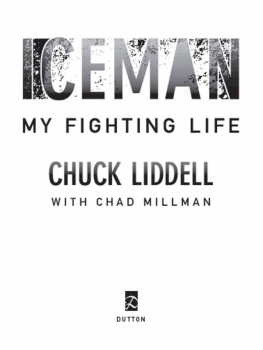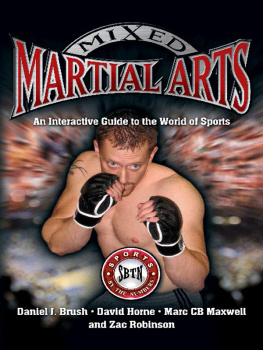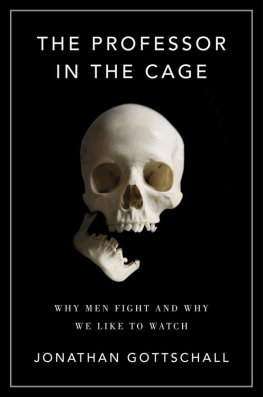REED KUHN
with KELLY CRIGGER
Fightnomics
The Hidden Numbers and Science in Mixed Martial Arts
... and why theres no such thing as a fair fight
By Reed Kuhn
With New Y ork Times Bestselling Author
Kelly Crigger
Fightnomics is a registered trademark of Calvert Strategies LLC.
Copyright 2013 by Graybeard Publishing LLC
All rights reserved. No part of this publication may be reproduced or distributed in any form or by any means, electronic or mechanical or stored in a database or retrieval system, without prior written permission from the publisher.
ISBN: 978-0-9912382-0-0
Graybeard is a registered trademark of Graybeard Publishing LLC Printed in the United States of America
Disclaimers:
Ultimate Fighting Championships (UFC), the Octagon, World Extreme Cagefighting (WEC), Strikeforce, Zuffa, PRIDE, and DREa are all registered trademarks, and are referenced here as part of the public domain.
fight nom ics
fight: an attempt to overcome opposition, especially physically, through confrontation -nomics: suffix meaning law; the laws defining the underlying properties of a given subject
This book is dedicated to the men and women of the Arena.
Where to Find Stuff
Prologue
1. Introduction: The Evolution of Combat Sports
2. Numbers in the Cage: What Stats Can Tell Us About Sports & MMA
How UFC Fights End (Take 2)
3. Advanced MMA Stats: The Standup Game
The Reality of Knockout Power: Size Matters
4. Beyond Standup: More MMA Striking Stats
6. Hacking the Tale of the Tape: How Size Matters, and How It Doesnt
7. Beyond the Measuring Tape: Rookies, Veterans, and Southpaws
The Youth Advantage
8. Assume the Position: Fighter Position & What it Tells Us
9. MMA Betting Lines: The Odds Are Good, but the Goods Are Odd
10. Fistful of Dollars: Fight Night Bonuses
Best Standup Strikers
12. For the Record: Settling the Biggest Debates in MMA (for now)
The Home-Cage Advantage
Missing More Than Just Weight
Agree to Disagree: MMA Judging
14. Deciphering the Fightnomics Uber Tale of the Tape
There really is no such thing as a fair fight. The first time this realization punched me in the gu1 was when Pete Williams knocked out Mark The Hammer Coleman at UFC 17. Williams was a 22 year old unknown in his UFC debut while Coleman was an Olympic silver medalist wrestler ant former UFC heavyweight champion who had ground and pounded through more impressive opponents, with his only loss being a decision in a championship fight. He was virtually unstoppable, and in my mind Williams was taking a quick trip to the hospital with a healthy dose of trauma counseling afterward. It was like watching Friday the 13th when idiot teenagers get drunk in Jasons house. You watch, but only to see them get whats coming for making such a horrible decision.
Within seconds Coleman had taken Williams to the mat and was implementing his very violent will and I was heading to the fridge for another beer. I thought this fight was already in the record books, but after twelve minutes there was no winner and we were going into a three-minute overtime. Suddenly Williams knocked Coleman out with a brutal head kick that hed set up with several low strikes. He rejoiced while the MMA worlds smartest guys slumped along with Colemans body. Using the basic fundamentals of mixed martial arts Williams negated Colemans strength and exploited his weaknesses. I was dumbfounded, awestruck, and kerfuffled.
Williams displayed the three main tenets of battle that every soldier learns - know yourself, know your enemy, and know the ground on which you fight. Utilizing these principles is what separates good fighters from the ones who get Gatorade commercials, but what about the rest of the chaotic chaos? A variety of external and internal factors can affect a fight - heart, chance, jitters, ring rust, and newborn babies - so the big question is how do we account for all those things?
With data.
Watching fight tapes to know your enemy and the ground you fight on is great, but its limited and only provides a fighter with a piece of the pugilistic puzzle. He still has to know himself and what he can and cannot do. Hard data is far more definitive and allows a fight camp to develop a sound strategy long before fight day.
Gathering and analyzing that information sounds like a simple concept, but in fact its laborious and monotonous to mine numbers from fight videos. Its even harder to then find patterns and develop actionable intelligence that arms a fighter with all the knowledge he needs to win. It also takes a 200-pound brain wired for science. I never would have believed someone could develop analysis that could be used to more accurately predict future performance in MMA based just on numbers. This is the first time anyone has had the hard drive and moxie to attempt it.
Ive always been skeptical of numbers because they can be skewed to reach whatever conclusion the writer desires. Numbers are the whores of bias that will lead you to whatever conclusion they want with just a little manipulation from the John. Thats why I like Reeds approach. He doesnt let the data become cheap or easy. He treats it with respect like a beloved daughter and presents it in a fair, unbiased way until its a bride at a white wedding and hes the proud papa giving it away. No one else has had the gumption to attempt anything like what Reed has accomplished, so hes a true trailblazer in MMA statistics and it was a no-brainer to get involved with this project. If hes Meriwether Lewis on a journey of discovery, then Ill happily be his William Clark.
While writing this book I learned exactly why Williams shocked everyone and defeated Coleman at UFC 17. While Colemans takedown attempts and accuracy were high and his time in a dominan position was even higher, his cardio endurance and head-strike defense were low, which tells us that he gets gassed and drops his hands more as the fight wears on. He was also a heavyweight and that weight class is more prone to knockouts than any other. A bad combination. Conversely Williamss takedown defense was solid, his cardio was steady, and his knockdown power was a real threat. Plus, he had the Youth Advantage on his side. While the casual observer saw a lopsided contest and bet on Coleman, the numbers told a different story and accurately outlined the outcome.
The factors were all there, but had not been added up yet. It was still an invisible matrix of voodoo that no one saw. Fifteen years later, we can see the sport more clearly. For me the future is clear: I will never venture to pick the winner of a fight without consulting Fightnomics first. Thank God for text messaging.
Kelly Crigger October, 2013
The Man in the Arena
It is not the critic who counts; not the man who points out how the strong man stumbles, or where the doer of deeds could have done them better.
The credit belongs to the man who is actually in the arena, whose face is marred by dust and sweat and blood; who strives valiantly; who errs, who comes short again and again, because there is no effort without error and shortcoming; but who does actually strive to do the deeds; who knows great enthusiasms, the great devotions; who spends himself in a worthy cause; who at the best knows in the end the triumph of high achievement, and who at the worst, if he fails, at least fails while daring greatly, so that his place shall never be with those cold and timid souls who neither know victory nor defeat.
Theodore Roosevelt
Excerpt from the speech Citizenship in a Republic delivered at the Sorbonne, in Paris, France April 23, 1910
Do you remember the moment you got hooked on MMA? I do. It was a Wednesday night in Nashville in 2009, but it started earlier than that. The mid-2000s were the heyday of the Iceman Chuck Liddell and the first rabid seasons of The Ultimate Fighter reality show. Professional mixed martial arts was penetrating the highly coveted 18-35 year old male demographic like a social virus. Dude, did you see this Ultimate Fighting stuff on Spike? was the hot button topic at gyms, bars, anc golf courses alike. At first blush the spectacle was fresh and foreign, yet easily understood. It was a perfect combination of primal skill and strength disguised as an exotic underground circus dealing the athletic taboos of unabashed blood loss, occasional unconsciousness, and the general perception of legalized violence. To my own peaceful and risk-averse mind it was enthralling. I didnt feel the usual need to put a stop to the conflict. I just sat back and watched it happen like a guilty pleasure, and apparently much of America felt the same.
Next page
